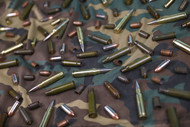Understanding Different Types of Ammunition: A Comprehensive Guide
Posted by Phantom Defense on Aug 5th 2024
Introduction to Ammunition
The world of ammunition is vast and diverse, ranging from the precise engineering of handgun ammo to the impactful power of buckshot. Understanding the different types of ammunition is essential for safe and proficient firearm operation. This guide explores various types of ammunition, their characteristics, and their uses.
Caliber
Definition and Importance
Caliber refers to the diameter of the gun barrel and, consequently, the diameter of the bullet that is fired. It is crucial to select the appropriate caliber for your specific needs, whether for hunting, self-defense, or competitive shooting. This ensures both effectiveness and safety.
Common Calibers
Common calibers include .22LR, 9mm, .45 ACP, and .308 Winchester. Each caliber serves different purposes and is suited for various firearms and applications.
Bullet vs Cartridge
Components of a Cartridge
A cartridge is the complete ammunition unit that includes the bullet (projectile), casing, gunpowder, and primer. Understanding the difference between a bullet and a cartridge is essential for discussing ammunition accurately.
Materials Used
Cartridges can be made from various materials, including brass, steel, and polymer. Each material has unique characteristics that affect performance, cost, and suitability for different applications.
Bullet Types
Full Metal Jacket (FMJ)
FMJ bullets have a soft core encased in a harder metal shell, which prevents deformation and allows for deeper penetration. They are commonly used for target shooting and competitions due to their reliability and performance.
Hollow Point (HP)
Hollow point bullets have a cavity in the tip that causes them to expand upon impact, increasing their stopping power. They are preferred for self-defense because they reduce the risk of over-penetration.
Soft Point (SP)
Soft point bullets offer a balance between expansion and penetration, making them versatile for hunting both large and small game. They provide better expansion than FMJs and deeper penetration than hollow points.
Rimfire vs Centerfire
Differences in Ignition Systems
The primary difference between rimfire and centerfire ammunition lies in the ignition system. Rimfire ammunition has the primer distributed around the rim, while centerfire ammunition has the primer in the center of the cartridge base. This affects reliability, range, and application.
Applications and Uses
Rimfire ammunition is often used for target shooting and small game hunting due to its lower cost and simpler design. Centerfire ammunition is more reliable and available in a broader range of calibers, making it suitable for self-defense, hunting, and competitive shooting.
Ammo for Each Firearm
Rifle Ammunition
Rifles fire ammunition with a single projectile designed for precision and long-distance shooting. Common types include FMJ for target shooting, soft point for hunting, and hollow point for tactical use.
Shotgun Shells
Shotgun ammunition includes birdshot, buckshot, and slugs. Birdshot is ideal for hunting birds and small game, buckshot is used for larger game and home defense, and slugs provide precision and stopping power for hunting larger game.
Handgun Ammunition
Handguns are versatile firearms that accommodate various ammunition types. FMJ is excellent for training, while hollow point is preferred for self-defense due to its stopping power.
Revolver Ammunition
Revolvers are known for their reliability and ease of use. Common ammunition includes FMJ for training, lead round nose for target practice, and hollow point for self-defense and hunting.
Choosing the Right Ammunition
Purpose and Use
When selecting ammunition, consider the intended use: target shooting, hunting, self-defense, or competition. Each activity requires specific types of ammunition, such as hollow points for self-defense and FMJ for target shooting.
Firearm Specifications
Always follow your firearm's specifications and manufacturer recommendations regarding caliber, bullet grain, and maximum pressure levels to ensure compatibility and safety.
Personal Preferences
Consider factors like recoil, cost, and personal comfort when choosing ammunition. Experimenting with different types and brands at the shooting range can help determine what works best for you.
Conclusion and Recommendations
Understanding the different types of ammunition and their uses is crucial for operating your firearm safely and effectively. Whether you are a hunter, sport shooter, or self-defense enthusiast, choosing the right ammo enhances your shooting experience and ensures optimal performance.

